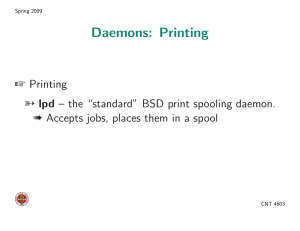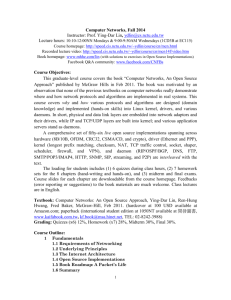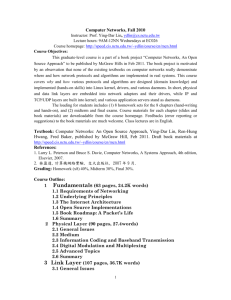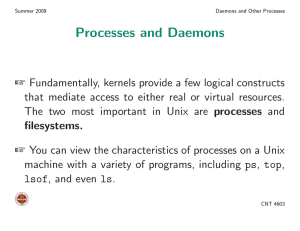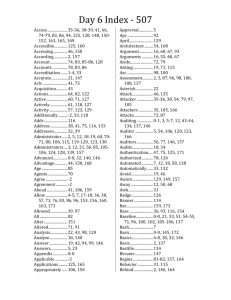Processes and Daemons
advertisement
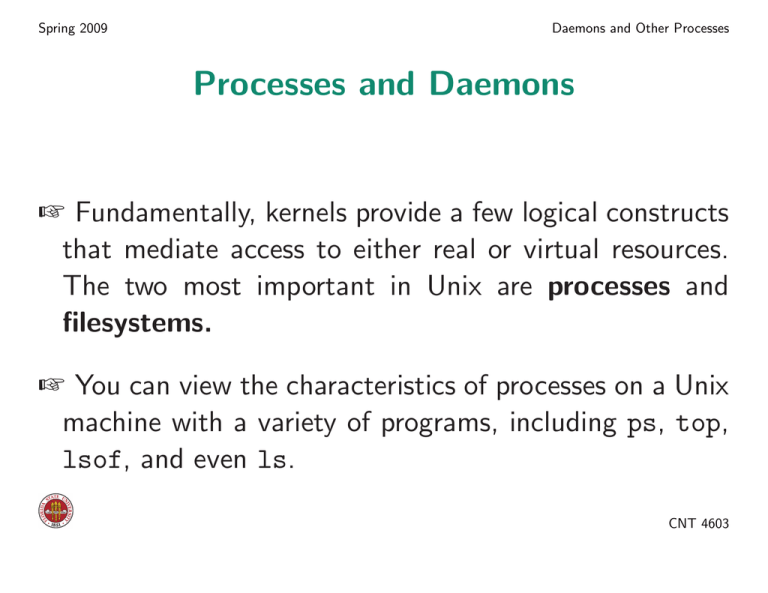
Spring 2009 Daemons and Other Processes Processes and Daemons + Fundamentally, kernels provide a few logical constructs that mediate access to either real or virtual resources. The two most important in Unix are processes and filesystems. + You can view the characteristics of processes on a Unix machine with a variety of programs, including ps, top, lsof, and even ls. CNT 4603 Spring 2009 Daemons and Other Processes What Unix/Linux system administrators see – ps [root@localhost root]# cat /etc/redhat-release Fedora release 8 (Werewolf) [root@localhost root]# ps -elf # This is SYSV; F S UID PID PPID C PRI NI TTY TIME 4 S root 1 0 0 75 0 ? 00:00:08 4 S root 1573 1384 0 75 0 tty 00:00:00 5 S root 7492 1 0 75 0 ? 00:01:08 1 S smmsp 7497 1 0 75 0 ? 00:00:00 5 S apache 25079 1321 0 75 0 ? 00:00:00 5 S apache 25080 1321 0 75 0 ? 00:00:00 5 S apache 25085 1321 0 75 0 ? 00:00:00 5 S apache 25086 1321 0 75 0 ? 00:00:00 Berkeley = ’ps axlww’ CMD init -bash sendmail: accepting sendmail: Queue run /usr/sbin/httpd /usr/sbin/httpd /usr/sbin/httpd /usr/sbin/httpd CNT 4603 Spring 2009 Daemons and Other Processes What system administrators see – ps 5 5 5 5 5 5 5 4 5 5 S S S S S S S S S S root root root root root root root root root root 13137 7492 16572 7492 18574 7492 20824 7492 22950 7523 23050 7523 32112 1151 32142 32112 32286 1 32317 7492 0 76 0 75 0 75 0 75 6 75 6 78 0 75 0 75 0 83 0 75 0 ? 00:00:00 sendmail: server [10.1. 0 ? 00:00:00 sendmail: k0CBPF4I01657 0 ? 00:00:00 sendmail: k0CBcKUk01857 0 ? 00:00:00 sendmail: k0CBs9CZ02082 0 ? 00:04:14 /usr/bin/perl 0 ? 00:03:58 /usr/bin/perl 0 ? 00:00:00 sshd: root@pts/0 0 pts/0 00:00:00 -bash 0 ? 00:00:00 sendmail: ./k0CD8sHV032 0 ? 00:00:00 sendmail: k0CD96Jh03231 CNT 4603 Spring 2009 Daemons and Other Processes What Unix/Linux system administrators see – top [root@localhost root]# top -b -n1 # run in batch mode for one iteration 08:17:41 up 1 day, 18:12, 2 users, load average: 9.69, 9.14, 8.89 115 processes: 114 sleeping, 1 running, 0 zombie, 0 stopped CPU states: cpu user nice system irq softirq iowait idle total 0.0% 0.0% 0.9% 0.0% 0.9% 0.0% 98.0% Mem: 510344k av, 392504k used, 117840k free, 0k shrd, 17208k buff 240368k actv, 55488k in_d, 4760k in_c Swap: 522104k av, 90392k used, 431712k free 72852k cached PID 1090 1 3 USER root root root PRI 20 15 15 NI 0 0 0 SIZE RSS SHARE STAT %CPU %MEM 1088 1088 832 R 0.9 0.2 492 456 432 S 0.0 0.0 0 0 0 SW 0.0 0.0 TIME CPU COMMAND 0:00 0 top 0:08 0 init 0:00 0 keventd CNT 4603 Spring 2009 Daemons and Other Processes What Unix/Linux system administrators see - lsof [root@localhost root]# lsof COMMAND PID USER NODE sendmail 20824 root 159526 sendmail 20824 root 159568 sendmail 20824 root 319023 sendmail 20824 root 32286 sendmail 20824 root 32104 sendmail 20824 root 32095 # heavily redacted to fit on page NAME /lib/libcrypt-2.3.2.so /lib/libcrypto.so.0.9.7a /usr/lib/libldap.so.2.0.17 /usr/lib/sasl/libcrammd5.so.1.0.19 /usr/kerberos/lib/libk5crypto.so.3.0 /lib/tls/libdb-4.2.so CNT 4603 Spring 2009 Daemons and Other Processes What system administrators see - lsof sendmail sendmail sendmail sendmail sendmail sendmail sendmail sendmail 20824 20824 20824 20824 20824 20824 20824 20824 root 318943 /usr/lib/libz.so.1.1.4 root 65611 /dev/null root TCP anothermachine.com:smtp->10.1.1.20: root 65611 /dev/null root 16220 socket root TCP anothermachine.com:smtp->10.1.1.20: root TCP localhost.localdomain:48512->localh root TCP anothermachine.com:smtp->10.1.1.20: CNT 4603 Spring 2009 Daemons and Other Processes Processes and Daemons : fork(2)and clone(2) + Fundamentally, kernels provide some logical constructs that mediate access to either real or virtual resources. The two most important in Unix are processes and filesystems. + A new process is created by fork(2); or, alternatively, in Linux with clone(2)since processes and threads are both just task struct in Linux. CNT 4603 Spring 2009 Daemons and Other Processes Processes and Daemons : fork(2)and clone(2) + With clone(2), memory, file descriptors and signal handlers are still shared between parent and child. + With fork(2), these are copied, not shared. CNT 4603 Spring 2009 Daemons and Other Processes Starting a Unix/Linux process + exec*()instantiates a new executable: ó Usually, when doing an exec*()the named file is loaded into the current process’s memory space CNT 4603 Spring 2009 Daemons and Other Processes Starting a Unix/Linux process ó Unless the first two characters of the file are #! and the following characters name a valid pathname to an executable file, in which that file is instead loaded ó If the executable is dynamically linked, then the dynamic loader maps in the necessary bits (not done if the binary is statically linked.) CNT 4603 Spring 2009 Daemons and Other Processes Starting a Unix/Linux process ó Then code in the initial “.text” section is then executed. (There are three main types of sections: “.text” sections for executable code, “.data” sections (including read-only “.rodata” sections), and “.bss” sections (Blocks Started by Symbol) which contains “uninitialized” data. CNT 4603 Spring 2009 Daemons and Other Processes Some Typical Assembly Code .file .data .align .type .size "syslog.c" 4 LogFile,@object LogFile,4 ; ; ; ; ; the file name this originated in a data section put PC on 4 (or 16) byte alignment create a reference of type object and give it 4 bytes in size CNT 4603 Spring 2009 Daemons and Other Processes Some Typical Assembly Code LogFile: .long -1 .align 4 .type LogStat,@object .size LogStat,4 LogStat: .long 0 .section .rodata ; ; ; ; ; ; ; ; address for object initialize to a value of -1 align . to 4 (16) byte a new object reference is created give it 4 bytes also here’s its address in memory and initialized it to a value zero here’s a ‘‘read-only’’ section CNT 4603 Spring 2009 Daemons and Other Processes Some Typical Assembly Code .LC0: .string "syslog" [ ... ] .text .globl syslog .type syslog,@function ; local label for a string ; initialized to "syslog" ; now we have some executable code ; and it iss a global symbol for ; a function syslog() CNT 4603 Spring 2009 Daemons and Other Processes Some Typical Assembly Code syslog: pushl movl subl %ebp %esp, %ebp $8, %esp ; and away we go... CNT 4603 Spring 2009 Daemons and Other Processes Daemon processes + When we refer to a daemon process, we are referring to a process with these characteristics: ó Generally persistent (though it may spawn temporary helper processes like xinetd does) CNT 4603 Spring 2009 Daemons and Other Processes Daemon processes ó No controlling terminal (and the controlling tty process group (tpgid) is shown as -1 in ps) ó Parent process is generally init (process 1) ó Generally has its own process group id and session id; CNT 4603 Spring 2009 Daemons and Other Processes Daemon processes + Generally a daemon provides a service. So why not put such services in the kernel? + Another level of modularity that is easy to control + Let’s keep from growing the already largish kernel CNT 4603 Spring 2009 Daemons and Other Processes Daemon processes + Ease (and safety) of killing and restarting processes + Logically, daemons generally share the characteristics one expects of ordinary user processes (except for the lack of controlling terminal.) CNT 4603 Spring 2009 Daemons and Other Processes BSD-ish: Kernel and user daemons: swapper + All UNIX processes have a unique process ID (pid). + An increasing number of daemons execute in kernel mode; (pagedaemon and swapper are two early examples from the BSD world); the rest still execute in user mode. CNT 4603 Spring 2009 Daemons and Other Processes BSD-ish: Kernel and user daemons: swapper + BSD swapper (pid 0) daemon ó The BSD swapper is a kernel daemon. swapper moves whole processes between main memory and secondary storage (swapping out and swapping in) as part of the operating system’s virtual memory system. CNT 4603 Spring 2009 Daemons and Other Processes BSD-ish: Kernel and user daemons: swapper ó SA RELEVANCE: In BSD-land, the swapper is the first process to start after the kernel is loaded. (If the machine crashes immediately after the kernel is loaded then you may not have your swap space configured correctly.) CNT 4603 Spring 2009 Daemons and Other Processes BSD-ish: Kernel and user daemons: swapper ó The swapper is described as a separate kernel process in other non-BSD UNIXes. It appears in the Linux process table as kswapd. It does appear on AIX, HPUX, IRIX; for example it appears in the Solaris process table as sched (the SysV swapper was sometimes called the scheduler because it ’scheduled’ the allocation of memory and thus influences the CPU scheduler). CNT 4603 Spring 2009 Daemons and Other Processes BSD: Kernel and user daemons: pagedaemon + BSD pagedaemon. In days gone by, the third process created by the kernel was always the pagedaemon and always had pid 2. These days, it’s just another in the rapidly proliferating “kernel processes” in BSD. The pagedaemon as a kernel process originated with BSD systems (demand paging was initially a BSD feature) which was adopted by AT&T. The pageout process CNT 4603 Spring 2009 Daemons and Other Processes (still pid 2) in Solaris provides the same function with a different name. CNT 4603 Spring 2009 Daemons and Other Processes BSD: Kernel and user daemons: pagedaemon + SA RELEVANCE: This is all automatic – not much for the SA to do, except monitor system behavior to make sure the system isn’t thrashing (you would expect to see this process taking up a lot of cpu time if there were thrashing.) CNT 4603 Spring 2009 Daemons and Other Processes Kernel and user daemons: init + init (pid 1) daemon: The first “user” process started by the kernel; its userid is 0. All other “normal” processes are children of init. Depending on the boot parameters init either: ó Spawns a single-user shell at the console CNT 4603 Spring 2009 Daemons and Other Processes Kernel and user daemons: init ó or begins the multi-user start-up scripts (which are, unfortunately, not standardized across UNIXes; see section 2.4 (starts on page 24) in USAH). There is a lot of flux in this area; we are seeing, for instance, in Fedora 10 replacement of the old SysV init with upstart; hopefully we can get better dependency resolution than we have had previously and faster boot times. (Take a look at /etc/event.d on Fedora 10 for instance.) CNT 4603 Spring 2009 Daemons and Other Processes Kernel and user daemons: update (aka bdflush/kupdate and fsflush) + update daemons: An update daemon executes the sync() system call every 30 seconds or so. The sync() system call flushes the system buffer cache; it is needed because UNIX uses delayed write when buffering file I/O to and from disk. CNT 4603 Spring 2009 Daemons and Other Processes Kernel and user daemons: update (aka bdflush/kupdate and fsflush) + SA RELEVANCE: It’s best not to just turn off a UNIX machine without flushing the buffer cache. It is better to halt the system using /etc/shutdown, /etc/halt, or poweroff; these commands attempt to put the system in a quiescent state (including calling sync()). CNT 4603 Spring 2009 Daemons and Other Processes Kernel and user daemons: update (aka bdflush/kupdate and fsflush) + I like to do something like sync ; sync ; poweroff or sync ; sync ; reboot just to make sure a few manual synchronizations are made. When I am removing a USB drive, I like to do something like sync ; umount /media/disk ; sync . + The update daemon goes by many names (see CNT 4603 Spring 2009 Daemons and Other Processes bdflush, bdflush(2), and kupdate in Linux and fsflush in Solaris). CNT 4603 Spring 2009 Daemons and Other Processes Kernel and user daemons: inetd and xinetd + Even though well-written daemons consume little CPU time they do take up virtual memory and process table entries. + Years ago, as people created new services, the idea of a super-daemon inetd was created to manage the class of network daemons. CNT 4603 Spring 2009 Daemons and Other Processes Kernel and user daemons: inetd and xinetd + Many network servers were mediated by the inetd daemon at connect time, though some, such as sendmail, postfix, qmail, and sshd were not typically under inetd. CNT 4603 Spring 2009 Daemons and Other Processes Kernel and user daemons: inetd and xinetd + The original inetd listened for requests for connections on behalf of the various network services and then started the appropriate daemon, handing off the network connection pointers to the daemon. CNT 4603 Spring 2009 Daemons and Other Processes Kernel and user daemons: inetd and xinetd + Some examples are pserver, rlogin, telnet, ftp, talk, and finger. + The configuration file that told inetd which servers to manage was /etc/inetd.conf. CNT 4603 Spring 2009 Daemons and Other Processes Kernel and user daemons: inetd and xinetd + The /etc/services file: This file maps TCP and UDP protocol server names to port numbers. + The /etc/inetd.conf file This file has the following format (page 824 in USAH and “man inetd.conf”): CNT 4603 Spring 2009 Daemons and Other Processes Kernel and user daemons: inetd and xinetd ó 1st column is the name of the service (must match an entry in /etc/services (or be in the services NIS map)) ó 2nd column designates the type of socket to be used with the service (stream or datagram) CNT 4603 Spring 2009 Daemons and Other Processes Kernel and user daemons: inetd and xinetd ó 3rd column designates the communication protocol (tcp is paired with stream sockets and udp is paired with datagram sockets) ó 4th column applies only to datagram sockets - if the daemon can process multiple requests then put ’wait’ here so that inetd doesn’t keeping forking new daemons CNT 4603 Spring 2009 Daemons and Other Processes Kernel and user daemons: inetd and xinetd ó 5th column specifies the username that the daemon should run under (for example - let’s have fingerd run as ’nobody’) ó remaining columns give the pathname and arguments of the daemons (here’s where TCP wrappers are typically installed). CNT 4603 Spring 2009 Daemons and Other Processes Kernel and user daemons: inetd and xinetd ó The successor to inetd was xinetd, which combined standard inetd functions with other useful features, such as logging and access control. CNT 4603 Spring 2009 Daemons and Other Processes Kernel and user daemons: inetd and xinetd ó The configuration file structure for xinetd is also different: /etc/xinetd.conf is used to modify general behavior of the daemon and the directory /etc/xinetd.d contains separate files per service. Your CentOS machines use xinetd instead of inetd. CNT 4603 Spring 2009 Daemons and Other Processes Kernel and user daemons: inetd and xinetd + SA RELEVANCE: When installing new software packages you may have to modify /etc/inetd.conf, /etc/xinetd.d/ files, and/or /etc/services. A hangup signal (kill -HUP SOMEPID) will get the inetd/xinetd to re-read its config file. Or you might be able to use a startup script, such as “/etc/init.d/inetd restart”) or “service inetd CNT 4603 Spring 2009 Daemons and Other Processes restart”. CNT 4603 Spring 2009 Daemons and Other Processes Kernel and user daemons: portmap and rpcbind + portmap/rpcbind : portmap (rpcbind on OpenSolaris and BSD) maps Sun Remote Procedure Call (RPC) services to ports (/etc/rpc). Typically, /etc/rpc looks something like: CNT 4603 Spring 2009 Daemons and Other Processes Kernel and user daemons: portmap [root@vm5 etc]# more /etc/rpc #ident ‘‘@(#)rpc 1.11 95/07/14 SMI’’ /* SVr4.0 # # rpc # portmapper 100000 portmap sunrpc rpcbind rstatd 100001 rstat rup perfmeter rstat_svc rusersd 100002 rusers nfs 100003 nfsprog ypserv 100004 ypprog mountd 100005 mount showmount ypbind 100007 walld 100008 rwall shutdown yppasswdd 100009 yppasswd CNT 4603 Spring 2009 Daemons and Other Processes Kernel and user daemons: portmap/rpcbind + Sun RPC is a backbone protocol used by other services, such as NFS and NIS. RPC servers register with this daemon and RPC clients get the port number for a service from the daemon. You can find operational information using rpcinfo. For example, rpcinfo -p will list the RPC services on the local machine. CNT 4603 Spring 2009 Daemons and Other Processes Kernel and user daemons: portmap/rpcbind + SA RELEVANCE: Some daemons may fail if portmap isn’t running. Most UNIXes these days automatically start up portmap after installation, so it’s usually not a problem. Also, there are subtle points that have oddly creeped in from the old tcpwrappers package that can affect the portmapper. See for example /etc/hosts.deny. CNT 4603 Spring 2009 Daemons and Other Processes Kernel and user daemons: syslogd + syslogd : syslogd is a daemon whose function is to handle logging requests from ó the kernel ó other user processes, primarily daemon processes ó processes on other machines, since syslogd can listen for logging requests across a network CNT 4603 Spring 2009 Daemons and Other Processes Kernel and user daemons: syslogd + A process can make a logging request to the syslogd by using the function syslog(3). syslogd determines what to do with logging requests according to the configuration file /etc/syslog.conf + /etc/syslog.conf generally looks something like: CNT 4603 Spring 2009 Daemons and Other Processes Kernel and user daemons: syslogd *.info;mail.none;news.none;authpriv.none;cron.none authpriv.* mail.* cron.* *.emerg uucp,news.crit local7.* /var/log/messages /var/log/secure /var/log/maillog /var/log/cron * /var/log/spooler /var/log/boot.log CNT 4603 Spring 2009 Daemons and Other Processes Kernel and user daemons: syslogd + SA RELEVANCE: For a single UNIX machine, the default /etc/syslog.conf will suffice. Also, you should note that Linux distributions have been moving to rsyslogd, which provides expanded capabilities (such as logging directly to a database) and still tries to preserve the capabilities of the original syslogd. + You should read the file and figure out where the most common error messages end up (/var/adm/messages CNT 4603 Spring 2009 Daemons and Other Processes or /var/log/messages are typical default locations). CNT 4603 Spring 2009 Daemons and Other Processes Kernel and user daemons: syslogd + If you are going to manage a number of UNIX machines, consider learning how to modify /etc/syslog.conf on the machines so all the syslog messages are routed to a single “LOGHOST”. CNT 4603

